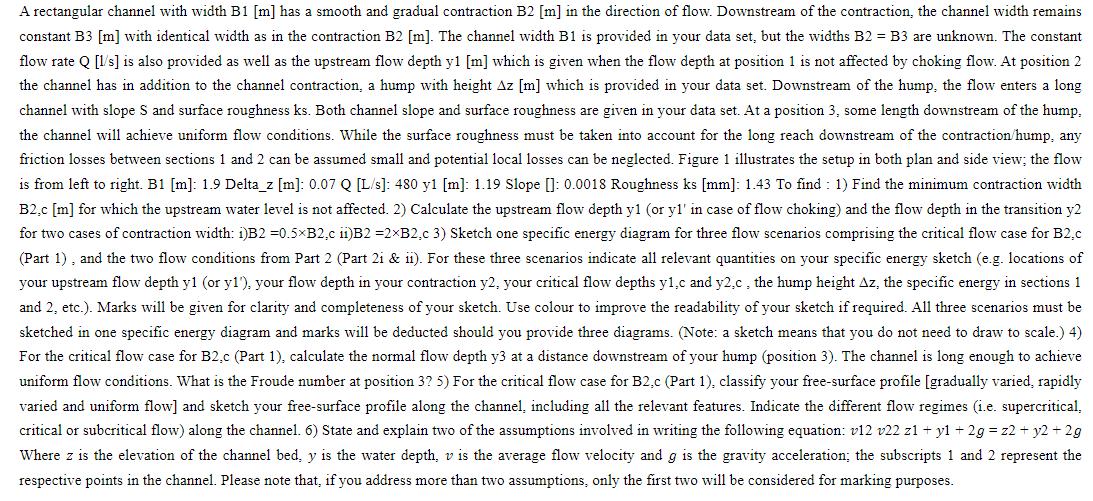Answered step by step
Verified Expert Solution
Question
1 Approved Answer
A rectangular channel with width B1 [m] has a smooth and gradual contraction B2 [m] in the direction of flow. Downstream of the contraction,

A rectangular channel with width B1 [m] has a smooth and gradual contraction B2 [m] in the direction of flow. Downstream of the contraction, the channel width remains constant B3 [m] with identical width as in the contraction B2 [m]. The channel width B1 is provided in your data set, but the widths B2 B3 are unknown. The constant flow rate Q [1/s] is also provided as well as the upstream flow depth y1 [m] which is given when the flow depth at position 1 is not affected by choking flow. At position 2 the channel has in addition to the channel contraction, a hump with height Az [m] which is provided in your data set. Downstream of the hump, the flow enters a long channel with slope S and surface roughness ks. Both channel slope and surface roughness are given in your data set. At a position 3, some length downstream of the hump. the channel will achieve uniform flow conditions. While the surface roughness must be taken into account for the long reach downstream of the contraction/hump, any friction losses between sections 1 and 2 can be assumed small and potential local losses can be neglected. Figure 1 illustrates the setup in both plan and side view; the flow is from left to right. B1 [m]: 1.9 Delta_z [m]: 0.07 Q [L/s]: 480 y1 [m]: 1.19 Slope []: 0.0018 Roughness ks [mm]: 1.43 To find : 1) Find the minimum contraction width B2.c [m] for which the upstream water level is not affected. 2) Calculate the upstream flow depth y1 (or yl' in case of flow choking) and the flow depth in the transition y2 for two cases of contraction width: i)B2 =0.5xB2,c 11)B2 =2xB2.c 3) Sketch one specific energy diagram for three flow scenarios comprising the critical flow case for B2.c (Part 1), and the two flow conditions from Part 2 (Part 2i & ii). For these three scenarios indicate all relevant quantities on your specific energy sketch (e.g. locations of your upstream flow depth y1 (or y1'), your flow depth in your contraction y2, your critical flow depths y1.c and y2.c, the hump height Az, the specific energy in sections 1 and 2, etc.). Marks will be given for clarity and completeness of your sketch. Use colour to improve the readability of your sketch if required. All three scenarios must be sketched in one specific energy diagram and marks will be deducted should you provide three diagrams. (Note: a sketch means that you do not need to draw to scale.) 4) For the critical flow case for B2,c (Part 1), calculate the normal flow depth y3 at a distance downstream of your hump (position 3). The channel is long enough to achieve uniform flow conditions. What is the Froude number at position 3? 5) For the critical flow case for B2,c (Part 1), classify your free-surface profile [gradually varied, rapidly varied and uniform flow] and sketch your free-surface profile along the channel, including all the relevant features. Indicate the different flow regimes (i.e. supercritical, critical or subcritical flow) along the channel. 6) State and explain two of the assumptions involved in writing the following equation: v12 v22 z1+y1 + 2g = z2 + y2 + 2g Where z is the elevation of the channel bed, y is the water depth, v the average flow velocity and g is the gravity acceleration; the subscripts 1 and 2 represent the respective points in the channel. Please note that, if you address more than two assumptions, only the first two will be considered for marking purposes.
Step by Step Solution
★★★★★
3.51 Rating (154 Votes )
There are 3 Steps involved in it
Step: 1

Get Instant Access to Expert-Tailored Solutions
See step-by-step solutions with expert insights and AI powered tools for academic success
Step: 2

Step: 3

Document Format ( 2 attachments)
635e3c0306502_182726.pdf
180 KBs PDF File
635e3c0306502_182726.docx
120 KBs Word File
Ace Your Homework with AI
Get the answers you need in no time with our AI-driven, step-by-step assistance
Get Started


